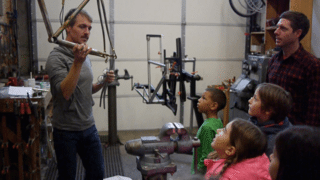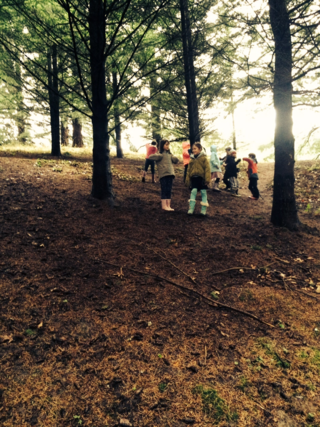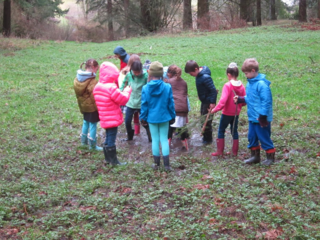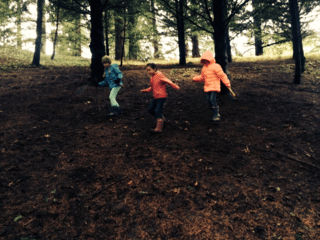Researching Play in the Arboretum

by Hannah Chandler
Part of our work in designing the playground has been rooted in understanding the work of design. What does design mean? How do designers do their work? Where do they find their inspiration? In order to better understand the work of designers, we visited several bike designers around Portland to interview them about their work and process. Interviewing designers helped students better understand the process of finding inspiration in the world around, growing and revising a small idea into something wonderful, and thinking and researching to figure out how to make something just right.
However, when we asked students to start thinking about where they could get their inspiration for designing the playground, they seemed to hit a stumbling blocks. We wondered if perhaps they needed to do more work with the idea of inspiration; what is it and where can it come from? We wondered about their experiences in finding and reflecting on inspiration. Students wanted to investigate other playgrounds to find ideas for their own. We wondered if they could find inspiration in something other than a playground. We decided to frame our Wednesday hike around the idea of researching play.
We wanted to see how different environments inspired play and how our experience in the Arboretum might influence our playground design work. We visited open areas, swampy areas, and enclosed wooden areas. At each place, we stopped and played and then reflected on three main questions: What do you notice about this area? What are you drawn to? What inspires you?
Our first stop was the upper meadow. I had anticipated that this largely open area would inspire big, spread out active play. I could not have been more wrong. Students immediately gravitated to the area under the big pine trees. The tree branches created a wonderful hidden area which conjured images of forts and buildings. The abundance of pine needles provided a wealth of resources as they were quickly imagined into matches, sewing materials, currency, and more.
NL: The scenery, the environment. The forest made me want to play in a different way. It changed the game. Here we were like explorers.
CW: The nature inspired us to play in a different way. All of a sudden we were characters in a story and these little pieces of sticks were matches. The materials gave us a game.
SM: We could have these materials on the playground!
NL: We could replicate this area on the playground.
PK: In the fantasy area, we could have these all these things, like little sticks and pine cones for playing with.
CM: I notice the bugs made me want to draw. We should have bugs in the playground.
DR: We could have a sign on the bug hotel that says you can draw these bugs.
Our second stop was in a magical triangle of green ferns and grass with a wet mossy swamp in the middle. It was quickly apparent how drawn the students were to the water. In addition to the joy of stomping, squelching, and squishing in the mud and water, students also noticed how the ferns, grasses, and moss made the area feel more like a fantasy land, a place where anything could happen. They also made connections to their hopes and dreams for the sand and water area on the new playground.
ZG: The swamp. I found a creek that led to the swamp. I think when it rains the water flows into the swamp.
NL: I liked the moss. I liked sinking into it.
CM: I liked the grass.
Teacher: You all were really drawn to the water. Does that connect to our playground?
SS: Sand and water!
CW: There's something about water. Everybody likes it.
NL: You can do experiments with water.
SM: The fantasy area could be like this.
ZG: There are different little spots here, spots that draw you in. I was surprised by the swamp. Maybe we could have little surprises everywhere.
MB: You can play anything here.
Our last stop was the running space, a place where students have been many times and of which they have many memories. We were running out of time, so I asked the students to use their memories to imagine what kind of play would happen here. They talked about how the openness of the space made it a place to run hard and fast, a place to be free, a place to cover a lot of ground quickly.
We returned to the classroom to do some writing about our experience:
SS: When we went to the upper meadow, the grass became wheat and there were knights and servants.
CM: How did the different spaces inspire your play? In the first place I felt WILD and free but in the second place I felt REALLY!!! free. It made me feel like I could play whatever I wanted.
NL: The first place we went to I was inspired by the scene because the scene changed what I played.
MC: The different parts of the arboretum invited different kinds of play. Here are some of the different areas we went to explore and more about the ideas. In the upper meadow, lots of kids were pretending they were animals in a big clump of evergreen trees. We were making fairy houses under the big oak tree.
On our hike as researchers of play, students quickly realized how the space and materials affected how they played. They noticed what they were drawn to. They noticed how their play changed depending on where they were. Next our work will be to translate this experience into playground design as we continue considering the details of each space on the playground. Some big questions for us right now include: how can each area invite students in to play? How can we design a playground that makes everyone happy? What materials and layout can we use to send a message about the kind of play that might happen in each area? How can colors, textures, heights, shapes, and sizes affect each area?




